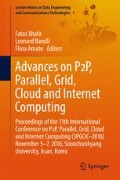Abstract
Radio Frequency Identification (RFID) technology is a kind of automatic recognition of communication technology. With the expansion of the RFID technology application areas, it needs to constantly improve the reliability, correctness and completeness of the RFID stream data. So data cleaning is significant to the RFID system. In recent years, many experts and scholars proposed a large number of cleaning algorithms according to RFID data flow characteristics. This paper gives a review on RFID data cleaning technology and some typical data cleaning algorithms.
Access this chapter
Tax calculation will be finalised at checkout
Purchases are for personal use only
Preview
Unable to display preview. Download preview PDF.
References
Zoltan K. Using Rfid And Gis Technologies For Advanced Luggage Tracking[J]. SEA-Practical Application of Science, 2015,2(8): 229-234.
Managing and mining sensor data[M]. Springer Science & Business Media, 2013.
Xie L, Yin Y, Vasilakos A V, et al. Managing RFID data: challenges, opportunities and solutions[J]. IEEE Communications Surveys & Tutorials, 2014, 16(3): 1294-1311.
Bai Y, Wang F, Liu P. Efficiently Filtering RFID Data Streams[C]. CleanDB, 2006:1-8.
Jeffery R, Alonso G, Franklin M J, et al. A pipelined framework for online cleaning of sensor data streams[J]. Computer Science, 2005:1-12.
JefferyR, Garofalakis M, Franklin M J. Adaptive cleaning for RFID data streams[C]. Proceedings of the 32nd international conference on Very large data bases(VLDB Endowment), 2006: 163-174.
Gonzalez H, Han J, Shen X. Cost-conscious cleaning of massive RFID data sets[C]. IEEE 23rd International Conference on Data Engineering. IEEE, 2007: 1268-1272.
Want T, Zhang J. Research on RFID data cleaning method based on particle filter[J].Electronic Technology & Software Engineering, 2014(1):214-215.
Chen Li.Research on Data Cleaning Methods in RFID Middleware [D].China: Wuhan University of Technology, 2013.
Metwally A, Agrawal D, El Abbadi A. Duplicate detection in click streams[C]. Proceedings of the 14th international conference on World Wide Web. ACM, 2005: 12-21.
Deng F, Rafiei D. Approximately detecting duplicates for streaming data using stable bloom filters[C]. Proceedings of the 2006 ACM SIGMOD international conference on Management of data. ACM, 2006: 25-36.
Wang YL, Wang C, Jiang XH,et al. RFID duplicate removing algorithm based on temporal-spatial Bloom Filter[J].Journal of Nanjing University of Science and Technology, 2015,39(3):253-259.
Zhang JZ, Fang Z, Xiong YJ, et al. Optimization algorithm for cleaning data based on SNM[J].Journal of Central South University (Science and Technology).2010,41(6):2240-2245.
Xu X,,Wang J,Yu Y.Research on full text index[J]. Computer Engineering.2002(2):101-103.
Carbunar B, Ramanathan M K, Koyuturk M, et al. Redundant-reader elimination in RFID systems[C]. IEEE SECON,2005:176-184.
Hsu C H, Chen Y M, Kang H J. Performance-effective and low-complexity redundant reader detection in wireless RFID networks[J]. EURASIP Journal on Wireless Communications and Networking, 2008(1): 1-9.
Jiang Y. Improvable-Redundant-Reader Elimination in RFID system[J].Computer Engineering and Applications. 2011,47(5):101-103.
Chen J,Yang Z.A Fast and Efficient Algorithm for Redundant Reader Elimination in RFID Application System[J].Computer Knowledge and Technology, 2009,5(16):4285-4288
Lv S,Yu S.A Middleware-Based Algorithm for Redundant Reader Elimination in RFID Systems[J]. ACTA ELECTRONICA SINICA.2012,40(5):965-970
Chen C. Research on Clean Technology of RFID Sensing Data of Manu-Facturing in IOT[D]. Guangdong University of Technology, 2014.
Author information
Authors and Affiliations
Corresponding author
Editor information
Editors and Affiliations
Rights and permissions
Copyright information
© 2017 Springer International Publishing AG
About this paper
Cite this paper
XU, H., DING, J., LI, P., LI, W. (2017). A Review on Data Cleaning Technology for RFID Network. In: Xhafa, F., Barolli, L., Amato, F. (eds) Advances on P2P, Parallel, Grid, Cloud and Internet Computing. 3PGCIC 2016. Lecture Notes on Data Engineering and Communications Technologies, vol 1. Springer, Cham. https://doi.org/10.1007/978-3-319-49109-7_35
Download citation
DOI: https://doi.org/10.1007/978-3-319-49109-7_35
Published:
Publisher Name: Springer, Cham
Print ISBN: 978-3-319-49108-0
Online ISBN: 978-3-319-49109-7
eBook Packages: EngineeringEngineering (R0)

